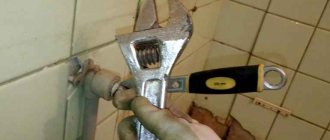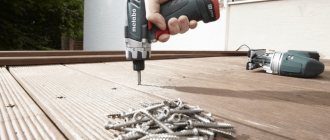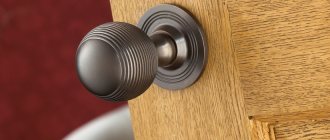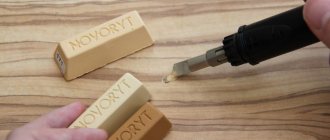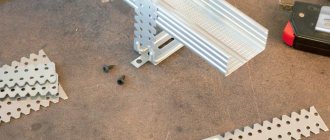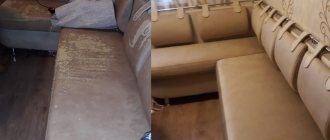As a rule, unscrewing hardware such as a self-tapping screw or screw does not cause problems. You just need to use a suitable tool (screwdriver, screwdriver or drill) and rotate the cap counterclockwise. But sometimes you need to remove a metal fastener whose cap (head) is torn off or whose thread is damaged. In this case, the task becomes more complicated. In this regard, many professionals will advise you to buy more self-tapping screws for insurance.
Previously, we told you about ways to remove a nail with a broken head. But even greater difficulties are caused by unscrewing the hardware if it does not have a head or the edges on the head are torn off. The problem can be solved in different ways.
Method two
If you need to unscrew deep-seated hardware, you simply will not be able to grab it due to the lack of a protruding part. You will have to damage the surface. Of course, you will have to fix the damaged area later, but this is the only option.
If the surface is wood, try using a chisel. If it is concrete, you can either make cuts using a grinder, or lightly process the desired area of the surface with a drill. Then, using pliers or pliers, you can pull out the hardware.
If you have to work with a metal screw, you will have to drill holes around it in order to then remove it with duckbills.
What to do if the first two methods did not work
If the previously described methods do not give the required effect, then additional tools and equipment will be required. In this sense, the engraver and cutting disc were able to prove themselves well. With their help, you can make a small cut on the head, and then the self-tapping screw will be unscrewed using the simplest slotted screwdriver.
For another method, you will need to go to the store to buy a special attachment for a screwdriver, which is called an “extract”. Such a cue ball has special slots, which, when rotated counterclockwise, will bite into the steel of the screw and find even the smallest remnants of slots in the head. They will also cling to them, which will contribute to unscrewing the screw.
This is the bat you should always keep on hand. In fact, there are many ways to unscrew a self-tapping screw or a screw with a broken slot, and most of them the craftsmen don’t even know about, which is why they spoil the surface, trying to pick up the head with side cutters or pliers.
Third way
If there is a head on the fastener and a torn slot (craftsmen use the term licked, rolled), you cannot use either a screwdriver or a drill - they will tear off the hardware. A small piece of rubber or rubberized fabric will help solve this problem. You can, for example, take a regular medical tourniquet or an inner tube from a bicycle wheel and cut a piece out of it in the shape of a rectangle or square. Then place it on the head of the fastener, insert a screwdriver and carefully unscrew the hardware. Thanks to the rubber gasket, which creates additional grip, the tool will not tear off the metal head. If the rubber breaks, cut another similar piece and continue working.
Briefly about the main thing
There are many ways to unscrew a self-tapping screw with a torn thread, worn out splines or a broken head. Some of them allow you to maintain the integrity of the surface and decorative finishing of the material, while others involve their damage or destruction. The choice depends on the final result of the dismantling work, whether you have one or another tool - an extractor, an engraver, a soldering iron, a tubular cutter, etc. But even with a simple screwdriver and glue or a piece of rubber, you can try to do this with minimal damage to the disassembled structure.
Question
Write in the comments what you think - do you know other ways to remove broken fasteners, or are the ones listed quite enough?
Method four
Do you know that you can recut the edges of a torn or damaged fastener head? To put it precisely, to deepen existing but worn-out ones. The easiest way to make one cut is to use a flat-tip screwdriver. You can make such a cut with a Dremel; a grinder or a metal saw will do. But if the self-tapping screw is made of hardened metal, it is difficult to use this option. In addition, part of the fastener should protrude slightly above the surface, only in this case the notch can be deepened.
It is generally accepted that
...a self-tapping screw is the same screw, but only in a modern version. In the old days, almost all fastenings were made using screws. To do this, you had to drill a hole and then screw a screw into it. Unlike screw fastening, self-tapping screws do not require additional preparation that will involve drilling a hole. They can be screwed using a screwdriver or even a regular screwdriver into any suitable surface.
According to external data, the differences between these two fastening elements are small. Screws in the upper part under the head have a smooth part of the shaft that does not have threads, but self-tapping screws have threads on the entire shaft up to the head. Ignorant people may not even immediately pay attention to such features, and will not even find the differences. In construction markets, small self-tapping screws are sold by weight, but large samples are sold individually.
Sixth method
Use an extractor. Although the purpose of this tool is to unscrew bolts, it can also be used when unscrewing fasteners such as self-tapping screws. The peculiarity of the tool is that when it is rotated counterclockwise, the gripping force of the fastener increases, preventing the hardware from being pulled out. Before using the extractor method, you will have to make a hole in the screw in the vertical direction - you will insert the tool into it. If you work with a self-tapping screw made of a hardened alloy, problems will arise - the drill will move to the side. But an ordinary screw can be easily removed in this way by using a thin drill.
If the cap protrudes
The easiest way to remove a screw is if it is not completely screwed in and the head can be grabbed with a hand or power tool. You have two ways:
- hold the head of the hardware with pliers and rotate them counterclockwise;
Source sdelaysam-svoimirukami.ru
- open the chuck of a screwdriver or drill to the size of the head, grab it, clamp it and turn the tool on in reverse rotation.
These methods of how to unscrew a self-tapping screw with torn edges can be used without harm to the surface only if the height of the protruding part of the hardware is sufficient for gripping. In other cases, scratches, chips and other damage cannot be avoided. Therefore, if the work needs to be done “cleanly,” methods for recessed heads are used.
Catalog > Building materials and products for construction. Construction work > Doors
Probably, at least once in your life, while disassembling a prefabricated structure, you have encountered the following problem - you need to unscrew a damaged screw with a slot or Phillips.
Screws can be screwed into wood thanks to threading. Ease of installation will be ensured by sharp turns that will not harm the inner layers of wood, will not reduce their hardness and will not allow the layers to move (which happens when fastening with nails). The shaft of the screw gradually tapers and ends with a sharp tip that penetrates the wood. When working with hard wood or in the case of a large diameter screw, a hole is made in advance with a drill of a smaller diameter.
The traditional requirement for fasteners for wood is the strength of installation. But over time, due to the operation and repair of structures, they have to be disassembled. Example: skewed door hinges that need to be corrected. They are secured with screws, and if one of them is “tightly” stuck, serious problems arise. Common situation?
One damaged screw can complicate repairs.
Instead of a cross-shaped recess, only a hole remained. How to unscrew such a screw?
There can be many reasons: a defective screw, a hole damaged from frequent screwing in fasteners, a damaged slot.
There is an obvious defect in the screw slot.
The slot on this screw is broken.
During the installation of fasteners, the screw simply breaks at the point of screwing in, when it is screwed in especially tightly, if you want to increase the strength of the installation. In such fastenings, the entire load falls on the screws. Because of this, their grooves “settle”, getting stuck in the wood, which subsequently leads to the fact that unscrewing the screws becomes a serious problem. In addition, to increase strength, the holes for the screws are filled with glue, sealants, mastics, oil varnishes, alabaster, and molten nylon. All this makes it very difficult to unscrew them; the fastener in the tree “let in the roots.” For example, in the manufacture of wooden boats, temporary fixation of glued boards is used. The boards are attached with screws, which are removed when the glue hardens. But the glue “grabs” the slot of the screw, making attempts to unscrew it a real Herculean task. Both the hole and the slot are damaged. Then, when removing the slot, the fastening materials are damaged. Even if adhesives are not used, corrosion can also do its dirty work: by rusting, the metal fastener becomes one with the wood.
What to do if the unfortunate piece of iron is stuck tightly, if its slot is so damaged that it cannot be unscrewed with a screwdriver? Do you know anything about a special attachment designed for unscrewing damaged screws? But thanks to it, removing a damaged and damaged screw is an easy task.
A set of nozzles used to remove fasteners.
The advantage of such “retractors,” also called extractors, is that their use does not damage materials and parts fastened with screws. The extractor is made of high strength hardened steel with chromium and vanadium. It is designed to remove damaged screws and screws. The extractor shape is constructed from a steel rod, the front working end of which (cone or cut cone shape) has a left cut. The other end of the tool has two or 4 edges that help fix it in the electric drill holder.
- steel rod:
- front part with left screw thread
- edged end
Threading is necessary so that the extractor rotates counterclockwise and unscrews the screw with the right-hand thread from the inside. Before this, the screw is drilled with a thin drill. A hole is formed inside the screw into which the end of the extractor enters, which, with the help of its turns, is fixed inside the damaged screw. The process is shown schematically in the figure:
- Working with a drill
- Extractor extraction
If you want to remove a damaged screw, you will need the following tools:
- electric drill (with variable movement, counterclockwise and clockwise), but a hand drill will also work,
- thin drill,
- extractor,
- center punch
- hammer
- vice
If the screw slot is broken and only the core remains from the wood, then you need to use a center punch to make a cone-shaped recess so that the drill does not come off later. Hit the punch with a hammer, but not too hard, because the diameter of the rod is already small, do not damage it even more. The point of the punch should be directly in the center of the rod.
If the screw slot is broken, use a punch to prepare a recess.
If the screw head is in place, but its slot is damaged, you can start drilling right away. The drill bit must match the diameter of the screw. The recommended drill size is 1/16. Do not forget that the screws taper towards the end, so it is enough to drill a small hole in the middle of the screw (approximately a third of the length). Make sure that you do not deviate from the drilling path, that the gimlet in the middle of the screw goes deep along the central axis, that it drills evenly through the middle.
Drill the screw shaft from the inside.
After pulling the drill bit out of the screw, insert the extractor into the drill holder instead and set the drill movement counterclockwise. The size of the extractor must match the size of the screw.
After drilling, set the drill movement counterclockwise
Insert the extractor into the drilled hole.
After inserting the screw end of the extractor into the screw hole, first turn it slowly, counterclockwise. Let it enter the screw and create a thread in the hole with its turns. Make sure it is well secured and secure the turns (to the same left side). Soon the screw will easily come out.
At the beginning, slow turns to the left. Screwing in
Increasing the speed, unscrew the screw.
The extractor should rotate counterclockwise.
If you want to release the extractor itself from the screw, clamp this fastener in a vice and turn the extractor to the right. The screw will remain in the vice and the tool will remain in the drill.
We use an extractor
In particularly difficult cases, when the screw cannot be removed even after heating, a device such as an extractor is used. This device is special equipment for an electric drill and is sold as a set of several attachments of different diameters. When using this tool, it is important to correctly determine the diameter of the problematic hardware and select equipment suitable for removing it. Before removing the screw, a pilot hole is drilled in its head, into which an extractor of suitable diameter is inserted. After this, turn on the drill or screwdriver and carefully unscrew the fasteners. We recommend how to choose an extractor.
Tool change
If the screwdriver always jumps off the slot, the reason may be that the pressure was worn out. In this case, the tool is replaced. A new screwdriver is inserted into the screw head, making sure that the pressure is pressed tightly against the slot, firmly entering the grooves, and they try to unscrew the fastener.
Necessary advice from Novate.ru: In the case when the fastener cannot be unscrewed, the first thing that needs to be done is to brake it. Trying to continue unscrewing can worsen the situation, and a screwdriver that constantly jumps off can destroy the material. Assess the condition of the screw and try other removal methods.
Heat and twist
As we have already said, wood is a material that is quite vulnerable to external influences and this feature can be used for your own purposes. To unscrew a stubborn screw from a wooden part, you can use a regular household hair dryer and a screwdriver. The area of the material where the screw is located is heated with a stream of air, and then, until the wood has cooled down, an attempt is made to remove the fastener. This method is based on the property of natural material to expand when heated and it is quite effective.
Increased torque
If the head of the hardware and the splines on it are not damaged, and the methods used did not produce results, you can try to increase the torque. This can be easily done in two ways:
- Place a screwdriver or tool bit into the recess, clamp with pliers and turn.
- A small flat-type screwdriver is installed in the slot as close to the edge of the head as possible. The handle of the screwdriver is hit hard with a hammer, trying to move the fastener from its place. If this happens, it is unscrewed in the usual way.
With this method, you need to be precise and careful not to damage the cap, otherwise you will have to use an extractor. It is not recommended for use on furniture and wood trim; if you make a mistake, you can hit the surface and damage it.
How to remove a broken screw from wood, wall or metal? Useful life hack
Probably no one has to solve as many small problems as men do when renovating a house, working in the garage or in the yard. Although, of course, women will probably not agree with this statement. They also often have to show dexterity and ingenuity, for example, in the kitchen - when cooking or cleaning. And each side in this dispute will be right in its own way. But today we will solve men's problems, or rather, one of them. We will teach you how to unscrew a broken screw or other threaded object.
p, blockquote 1,0,0,0,0 —>
If the self-tapping screw breaks. How can I get it? Easy way
As a rule, the head of the self-tapping screw flies off. In this case, you won’t be able to hook it with a screwdriver bit or just a screwdriver and unscrew it along the threads. We need to look for some other way to solve the problem. And there is such a way.
p, blockquote 2,0,0,0,0 —>
What can be done?
If you break a self-tapping screw while unscrewing or tightening it, and at that moment it has already been partially unscrewed.
p, blockquote 3,0,1,0,0 —>
p, blockquote 4,0,0,0,0 —>
The problem can be solved quite simply. To unscrew the rest of the broken screw, you need to secure it in the chuck of a screwdriver or drill and slowly unscrew it.
p, blockquote 5,0,0,0,0 —>
The main thing is to immediately engage the remaining self-tapping screw well and tighten the drill or screwdriver chuck. And to unscrew this “stub” you do not need to turn on the power tool at high speeds. It is better to unscrew the screw at low speeds.
p, blockquote 6,0,0,0,0 —>
That's the whole trick. Agree, there is nothing complicated here. Take note, maybe it will come in handy.
p, blockquote 7,1,0,0,0 —>
p, blockquote 8,0,0,0,0 —>
And watch 2 videos where they will show you more options for solving this and similar problems. Video No. 1.
p, blockquote 9,0,0,0,0 —>
p, blockquote 10,0,0,0,0 —>
p, blockquote 11,0,0,1,0 —>
p, blockquote 12,0,0,0,0 —>
PS Tell your friends how to get a self-tapping screw if its head is broken. Please share the post with them on social networks. I will be very grateful to you for this.
p, blockquote 13,0,0,0,0 —>
p, blockquote 14,0,0,0,0 —>
Did you like the article? Share with your friends!
What repels mosquitoes at night at home?
How to remove small pimples?
How to choose the right citrus fruits? Useful life hack
How to determine the ripeness of a melon? Simple trick
I wake up at night and can't sleep. What's wrong?
When to plant fruit tree seedlings in the fall?
Another way to get rid of hiccups. Take note!
When is the best time to drink water?
Checking headphones for sound quality. Best track
If you are forced to work on weekends? What to do?
A simple and effective remedy for sore throat for adults
How to quickly get rid of gas and bloating?
If the light in the apartment goes out. How can I find out only from you, or from my neighbors?
How to cross out a word so that it cannot be read?
How to make French fries crispy? Useful life hack
How to unscrew a licked screw
So, if you don’t have a bolt extractor at hand, as in the pictures, then you can try to unscrew the licked screw, using a piece of thin rubber for this purpose. To do this, take a piece of rubber and place the screwdriver attachment under the PH2. A little pressure, and, as a rule, the licked screw will come out (see remstroisovet.ru).
You can try to unscrew the self-tapping screw with a licked head by heating it. This method is only suitable if the self-tapping screw is screwed into a non-flammable base. To use it, just heat the head of the screw with a lighter or gas torch, and then wait until the hardware cools down. Due to the expansion of the metal, a larger space is formed around the self-tapping screw, and it should freely come out of the material if it is picked up by the head with pliers.
If the self-tapping screw does not want to unscrew, then there is nothing left to do but drill it out using a drill and a metal drill of a suitable diameter for this purpose. Having carefully gotten rid of the head of the screw, you should change the drill to a thinner drill, after which, without damaging the material, you can quite easily remove the stuck screw.
How can you unscrew a rusty bolt?
Depending on the size of the bolt, take a strong flathead screwdriver or chisel and use a hammer to try to unscrew the resting part with blows. The second method is to heat the part using a gas burner, soldering iron, industrial hair dryer, blowtorch or regular gas burner.
Interesting materials:
What is an extra rinse in a washing machine? What is dpi when printing? What is unit division of labor? What is ESP in a car? What is a flagship office? What is flux and soldering acid? What is force majeure in a contract? What is a frontal photo? What is hydrophilic property? What is Glass N TPU case?
Cleaning the screw
In some cases, cleaning the screw from the paint may be effective. Often, varnish or paint makes it difficult to turn fasteners. This coating can be removed using a small amount of solvent and heating the area.
If the screw is deeply set, its head is damaged, and the tip does not come out on the back side, you will have to touch the area around it.
When using any method, you need to consider the following points:
- If you have access to the back of the workpiece, you should inspect it. If there is a protruding end of the screw, you can try to unscrew it using pliers.
- The fasteners must be rotated in the correct direction, since some types may have a reverse thread.
- A bolt or self-tapping screw of a larger diameter can be installed into the vacated cavity.
- When performing work, you must use personal protective equipment - gloves and goggles.
< Previous Next >
Option seven
Use welding. In other words, weld a nut, some kind of rod or lever to a fragment of a screw or screw, which will allow you to remove the fastener without effort. Some use the cold welding method, others consider it unreliable and weld the alloy.
In this case, if the self-tapping screw or screw is in the wood surface, they can be heated, all with the same soldering iron. The alloy will expand, then contract again, the wood around it will be slightly burned and the fasteners will come out much easier.
How to unscrew a screw with torn edges [Instructions]
Screws are used primarily to connect wood pieces to each other. In some cases, they are also used for metal structures (for example, connecting profiles when installing drywall or OSB boards). Since screws are rarely made of hardened metal, they have a slightly higher failure rate than bolts, for example.
Edge notch
In the case of a broken screw head or worn edges, you can create a notch on the head for better support for a flat-head screwdriver. The notch is applied using a Dremel, grinder or other tool that cuts through the alloy. But with this method, the surface of the material will be damaged if the screw sits deep.
Necessary advice: If the material allows, you can use the property of the alloy to expand when heated and contract when cooled. Stuck fasteners are heated using a lighter, soldering iron or hair dryer. The screw will grow slightly, pushing the material apart, and when it cools down, it will return to its previous state. As a result, a microscopic gap may appear between the rod and the material, which will slightly loosen the fastening and make it easier to unscrew.
Drill completely
When all of the above methods have failed, there is a radical way to remove stuck fasteners. The screw or screw is completely drilled out to the base. Then a new fastener with a larger diameter is inserted into the hole.
Practical advice: When removing a stuck fastener, you must follow safety precautions. During the drilling process, iron shavings are generated, scattered around, and getting into the eyes can cause injury. At the end of the work, remove the shavings with a brush or sponge so as not to destroy the skin on your hands.
Did you like the article? Then support us, press
:
